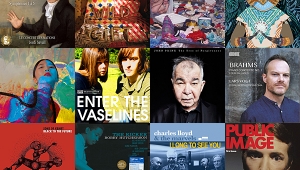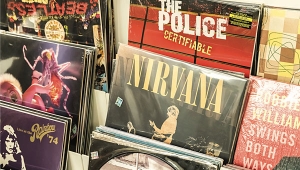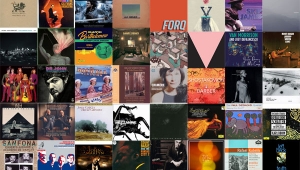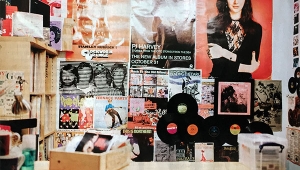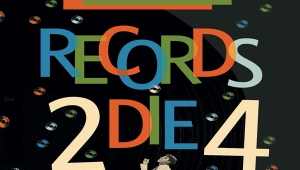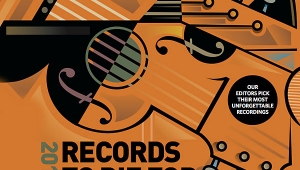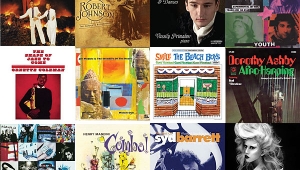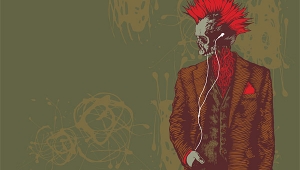| Columns Retired Columns & Blogs |
1999 Records To Die For Page 16
Peter van Willenswaard
TCHAIKOVSKY: Symphony 6
Evgeny Svetlanov, State Symphony Orchestra of the Russian Federation
Emergo Classics EC 3624-2 (CD). 1993. Tomoyashi Ezaki, prod.; Robert de Godzinsky, eng. DDD. TT: 46:26
There are many performances of this symphony (see "Building a Library," Stereophile, April 1996, p.273), and I possess 30 of them, but this one, recorded in concert in Tokyo, is my favorite. It is very emotional: mindlessly desperate in its fortes, deeply sad in its ppps. Svetlanov unleashes the orchestra—it nearly explodes. Sound quality is questionable. There is stereo image, depth, and ambience, but the violins are harsh, and the sound of the cooling fan on Svetlanov's desk is prominent during the soft passages. I don't care—this is music.
ULLA MEINECKE: Wenn Schon Nicht für Immer, dann Wenigstens für Ewig
RCA PL 28545 (LP). 1983. Uno Arndt, prod., eng. AAA. TT: 36:28
This is one of the few older pop records I regularly reach for—not to evaluate my newest whatever, but simply to enjoy. Meinecke's voice is powerful when it needs be, but can also be soft and intimate. Most of all, her voice is sympathetic. Her version of Paul Simon's "Fifty Ways to Leave Your Lover" is an ear-opener. All lyrics are pure, and blend perfectly with the music. As can be guessed from the title, all texts are in German. Sonics are exemplary: the sound is big and clean without being clinical, sound effects are subtle, and the sense of space is enormous.
PAGANINI: Violin Concerto 1
TCHAIKOVSKY: Violin Concerto
Neeme Järvi: The Early Recordings, Vol.2
Viktor Tretyakov, violin; Neeme Järvi, Moscow Philharmonic Orchestra
Melodiya 40720 (CD). 1966/1997. Alexander Grossmann, Igor Veprintsev, engs. ADD. TT: 70:25
The title "Records To Die For" is particularly apt in this case. Originally released on LP in the late 1960s, this quickly became my favorite violin recording when I first heard it as an 18-year-old violin student. Nineteen-year-old Viktor Tretyakov was an emerging star; his virtuoso performance of the Paganini concerto's first movement—that cadenza!—and his first prize in the Tchaikovsky Competition declared to the world the arrival of a sensationally gifted performer. But this was the Soviet era, when sensationally gifted artists often ran afoul of the authorities. I always assumed that's what happened to Tretyakov, because the album soon went out of print and the young violinist wasn't heard of again for many years. Since the early days of CDs, I've looked for the reissue of this unforgettable recording.
KANTATE: German Baroque Cantatas
Works by J.C. Bach, Buxtehude, Erlebach, Rovetta, Schütz, Tunder
Andreas Scholl, countertenor; Concerto di Viole, Basel Consort
Harmonia Mundi 901651 (CD). 1998. Nicolas Bartholomee, prod., eng. DDD. TT: 71:50
It's rare that a solo vocal recording works some kind of magic, but this one—due primarily to the unbelievably gorgeous and technically flawless voice and singing of Andreas Scholl—casts a spell that remains long after the music stops. Yes, Scholl is a countertenor, and no, he doesn't sound like any countertenor you've ever heard. The seamless, consistent tonal quality from lowest to highest notes is a marvel, and the sheer warmth and beauty of the sound renders categorization irrelevant. This simply is an exceptional and eminently listenable voice, no matter what its type. And the music—virtually unknown Baroque solo-vocal cantatas variously accompanied by viols, guitar, organ, or harpsichord—is amazingly beautiful in its own right, and perfectly suited to Scholl's voice.
AGNUS DEI
Edward Higginbottom, The Choir of New College, Oxford
Erato 14634-2 (CD). 1996. Tim Oldham, Oliver Rivers, prods.; Richard Lee, eng. DDD. TT: 72:36
Agnus Dei is a stunning anthology of 12 sacred choral masterpieces drawn from four different centuries. Although each shortish piece is compelling in its own right, the most poignant works are a choral setting of Samuel Barber's Adagio for Strings, Elgar's Lux Aeterna, and Allegri's absolutely ethereal Miserere mei, Deus. The all-male choir of New College, Oxford, is as English as they come and produces a rapturously pure sound. There's nothing to fault and everything to delight in. Only the most cynical of souls wouldn't be transported and ravished by these performances. No wonder that, when it was first released, this CD held the top spot on the British bestseller list for weeks.
BRAHMS: Symphonies 1-4, Academic Festival Overture, Variations on a Theme by Haydn
Sir Charles Mackerras, Scottish Chamber Orchestra
Telarc CD-80450 (3 CDs). 1997. James Mallinson, prod.; Jack Renner, Tony Faulkner, engs. DDD. TT: 3:18:58
Some authentic performances on period instruments exist merely for their own sake, as intellectual exercises. And then there's "authenticity," which seeks only to serve the music and the composer's intentions, and which simultaneously opens up the music to fresh perspectives. Charles Mackerras' cycle of the Brahms symphonies falls into the latter camp; he and the fluent Scottish Chamber Orchestra capture (as best it can be captured) the "style of the original Meiningen performances," as the accompanying booklet so aptly puts it. That style means a fluidity in dynamics and tempo that results in expressive responsiveness on an almost measure-by-measure basis. In wrong or wayward hands, the result could be disastrous, but Mackerras is too thorough a musician for that—here he is in total harmony with Brahms' music and style. Own this set and you can forget the many competing cycles.
RICHIE COLE: West Side Story
Richie Cole, alto sax; Vic Juris, guitar; Lou Forestieri, piano; Ed Howard, bass; Tommy Campbell, drums; Ray Mantilla, percussion
MusicMasters Jazz 65165-2 (CD). 1991 Todd Barkan, prod.; Troy Halderson, eng. DDD? TT: 51:45
West Side Story is a national treasure: timeless story, timeless music. Saxophonist Richie Cole, an alumnus of the Buddy Rich Big Band and a protégé of Phil Woods, here gives Leonard Bernstein's most memorable creations a lyrically improvisational spin. His crew of ace sidemen are wonderful supporting players, but Cole is always upfront in the mix, and deservedly so—he loves these tunes, and it shows. Tracks To Die For: "Maria" and "Somewhere." Cole honors the spirit of the musical and its composer with his own piece, "West Side Blues," based on Bernstein's compositions. This disc has staying power: it's been in heavy rotation chez moi for more than a year.
JOAN OSBORNE: Relish
Blue Gorilla/Mercury 314 526 699-2 (CD). 1995. Rich Chertoff, prod.; William Whitman, Rob Hyman, engs. DDD? TT: 61:19
"What if God was one of us? / Just a stranger on the bus / trying to make his way home?" Joan Osborne, streetwise spiritualist, asked these naïvely poignant questions in her breakthrough single, "One of Us." With an intentionally rough sonic edge as reinforcement, Relish expands on the theme: gritty portraits of manic depressives ("Crazy Baby"), urban angels ("St. Teresa"), religious-fanatic recluses ("Pensacola"), and grim mornings-after ("Right Hand Man"). In Bob Dylan's "Man in the Long Black Coat," she explores the dark attraction to mysterious, otherworldly strangers more evocatively than the songwriter himself ever could. Can some people live in the gutter with their eyes on the stars? Joan Osborne thinks so. God, she reminds us, can be found not only at the top of the pyramid, but also at the bottom. (XIX-2)
TCHAIKOVSKY: Symphony 6
Evgeny Svetlanov, State Symphony Orchestra of the Russian Federation
Emergo Classics EC 3624-2 (CD). 1993. Tomoyashi Ezaki, prod.; Robert de Godzinsky, eng. DDD. TT: 46:26
There are many performances of this symphony (see "Building a Library," Stereophile, April 1996, p.273), and I possess 30 of them, but this one, recorded in concert in Tokyo, is my favorite. It is very emotional: mindlessly desperate in its fortes, deeply sad in its ppps. Svetlanov unleashes the orchestra—it nearly explodes. Sound quality is questionable. There is stereo image, depth, and ambience, but the violins are harsh, and the sound of the cooling fan on Svetlanov's desk is prominent during the soft passages. I don't care—this is music.
ULLA MEINECKE: Wenn Schon Nicht für Immer, dann Wenigstens für Ewig
RCA PL 28545 (LP). 1983. Uno Arndt, prod., eng. AAA. TT: 36:28
This is one of the few older pop records I regularly reach for—not to evaluate my newest whatever, but simply to enjoy. Meinecke's voice is powerful when it needs be, but can also be soft and intimate. Most of all, her voice is sympathetic. Her version of Paul Simon's "Fifty Ways to Leave Your Lover" is an ear-opener. All lyrics are pure, and blend perfectly with the music. As can be guessed from the title, all texts are in German. Sonics are exemplary: the sound is big and clean without being clinical, sound effects are subtle, and the sense of space is enormous.
![]()
David Vernier
PAGANINI: Violin Concerto 1
TCHAIKOVSKY: Violin Concerto
Neeme Järvi: The Early Recordings, Vol.2
Viktor Tretyakov, violin; Neeme Järvi, Moscow Philharmonic Orchestra
Melodiya 40720 (CD). 1966/1997. Alexander Grossmann, Igor Veprintsev, engs. ADD. TT: 70:25
The title "Records To Die For" is particularly apt in this case. Originally released on LP in the late 1960s, this quickly became my favorite violin recording when I first heard it as an 18-year-old violin student. Nineteen-year-old Viktor Tretyakov was an emerging star; his virtuoso performance of the Paganini concerto's first movement—that cadenza!—and his first prize in the Tchaikovsky Competition declared to the world the arrival of a sensationally gifted performer. But this was the Soviet era, when sensationally gifted artists often ran afoul of the authorities. I always assumed that's what happened to Tretyakov, because the album soon went out of print and the young violinist wasn't heard of again for many years. Since the early days of CDs, I've looked for the reissue of this unforgettable recording.
On a trip to St. Petersburg, Russia, a few years ago, I was on a quest for a copy when I was roughed up by a gang of street boys. I didn't find the disc, but this experience only hardened my determination to do so. Last year, the reward came with the release of the Järvi/Melodiya series. The Sonic Solutions remastered sound improves but doesn't eliminate some trebly residue. But the performances—the bold and brilliant Paganini and the daring and dangerous Tchaikovsky—are even better than I remember them.
KANTATE: German Baroque Cantatas
Works by J.C. Bach, Buxtehude, Erlebach, Rovetta, Schütz, Tunder
Andreas Scholl, countertenor; Concerto di Viole, Basel Consort
Harmonia Mundi 901651 (CD). 1998. Nicolas Bartholomee, prod., eng. DDD. TT: 71:50
It's rare that a solo vocal recording works some kind of magic, but this one—due primarily to the unbelievably gorgeous and technically flawless voice and singing of Andreas Scholl—casts a spell that remains long after the music stops. Yes, Scholl is a countertenor, and no, he doesn't sound like any countertenor you've ever heard. The seamless, consistent tonal quality from lowest to highest notes is a marvel, and the sheer warmth and beauty of the sound renders categorization irrelevant. This simply is an exceptional and eminently listenable voice, no matter what its type. And the music—virtually unknown Baroque solo-vocal cantatas variously accompanied by viols, guitar, organ, or harpsichord—is amazingly beautiful in its own right, and perfectly suited to Scholl's voice.
![]()
J.P. Wearing
AGNUS DEI
Edward Higginbottom, The Choir of New College, Oxford
Erato 14634-2 (CD). 1996. Tim Oldham, Oliver Rivers, prods.; Richard Lee, eng. DDD. TT: 72:36
Agnus Dei is a stunning anthology of 12 sacred choral masterpieces drawn from four different centuries. Although each shortish piece is compelling in its own right, the most poignant works are a choral setting of Samuel Barber's Adagio for Strings, Elgar's Lux Aeterna, and Allegri's absolutely ethereal Miserere mei, Deus. The all-male choir of New College, Oxford, is as English as they come and produces a rapturously pure sound. There's nothing to fault and everything to delight in. Only the most cynical of souls wouldn't be transported and ravished by these performances. No wonder that, when it was first released, this CD held the top spot on the British bestseller list for weeks.
BRAHMS: Symphonies 1-4, Academic Festival Overture, Variations on a Theme by Haydn
Sir Charles Mackerras, Scottish Chamber Orchestra
Telarc CD-80450 (3 CDs). 1997. James Mallinson, prod.; Jack Renner, Tony Faulkner, engs. DDD. TT: 3:18:58
Some authentic performances on period instruments exist merely for their own sake, as intellectual exercises. And then there's "authenticity," which seeks only to serve the music and the composer's intentions, and which simultaneously opens up the music to fresh perspectives. Charles Mackerras' cycle of the Brahms symphonies falls into the latter camp; he and the fluent Scottish Chamber Orchestra capture (as best it can be captured) the "style of the original Meiningen performances," as the accompanying booklet so aptly puts it. That style means a fluidity in dynamics and tempo that results in expressive responsiveness on an almost measure-by-measure basis. In wrong or wayward hands, the result could be disastrous, but Mackerras is too thorough a musician for that—here he is in total harmony with Brahms' music and style. Own this set and you can forget the many competing cycles.
![]()
Barry Willis
RICHIE COLE: West Side Story
Richie Cole, alto sax; Vic Juris, guitar; Lou Forestieri, piano; Ed Howard, bass; Tommy Campbell, drums; Ray Mantilla, percussion
MusicMasters Jazz 65165-2 (CD). 1991 Todd Barkan, prod.; Troy Halderson, eng. DDD? TT: 51:45
West Side Story is a national treasure: timeless story, timeless music. Saxophonist Richie Cole, an alumnus of the Buddy Rich Big Band and a protégé of Phil Woods, here gives Leonard Bernstein's most memorable creations a lyrically improvisational spin. His crew of ace sidemen are wonderful supporting players, but Cole is always upfront in the mix, and deservedly so—he loves these tunes, and it shows. Tracks To Die For: "Maria" and "Somewhere." Cole honors the spirit of the musical and its composer with his own piece, "West Side Blues," based on Bernstein's compositions. This disc has staying power: it's been in heavy rotation chez moi for more than a year.
JOAN OSBORNE: Relish
Blue Gorilla/Mercury 314 526 699-2 (CD). 1995. Rich Chertoff, prod.; William Whitman, Rob Hyman, engs. DDD? TT: 61:19
"What if God was one of us? / Just a stranger on the bus / trying to make his way home?" Joan Osborne, streetwise spiritualist, asked these naïvely poignant questions in her breakthrough single, "One of Us." With an intentionally rough sonic edge as reinforcement, Relish expands on the theme: gritty portraits of manic depressives ("Crazy Baby"), urban angels ("St. Teresa"), religious-fanatic recluses ("Pensacola"), and grim mornings-after ("Right Hand Man"). In Bob Dylan's "Man in the Long Black Coat," she explores the dark attraction to mysterious, otherworldly strangers more evocatively than the songwriter himself ever could. Can some people live in the gutter with their eyes on the stars? Joan Osborne thinks so. God, she reminds us, can be found not only at the top of the pyramid, but also at the bottom. (XIX-2)
- Log in or register to post comments

